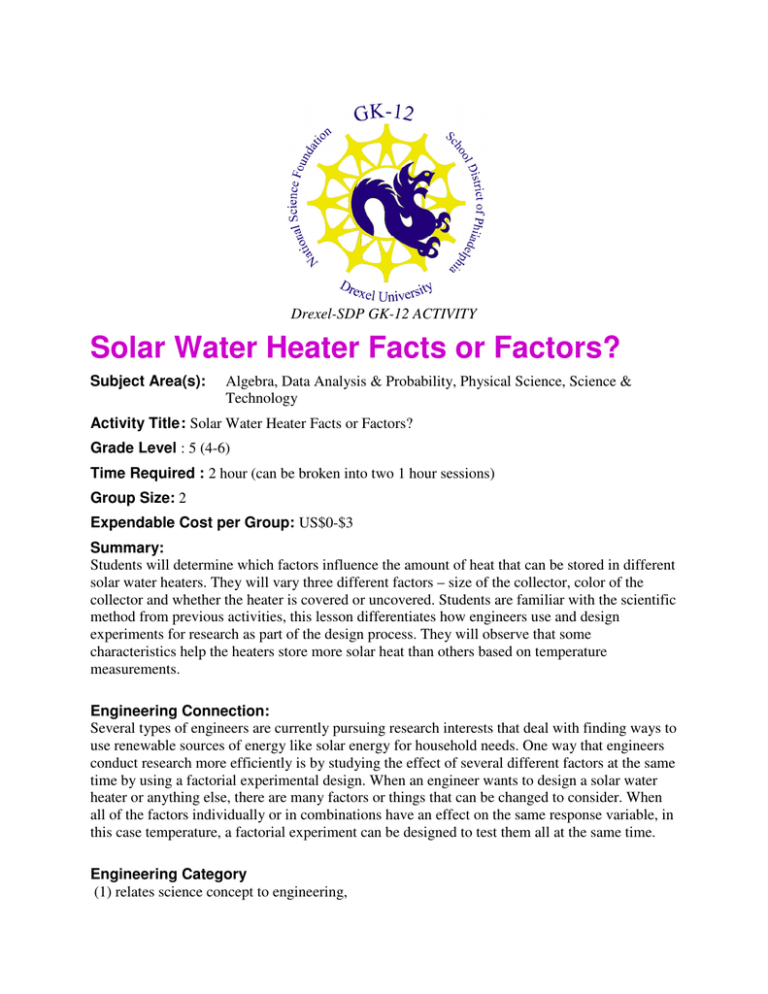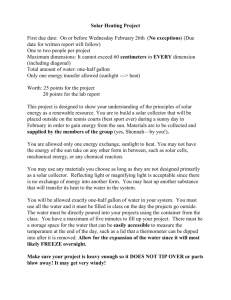Solar Water Heater Facts or Factors?
advertisement

Drexel-SDP GK-12 ACTIVITY Solar Water Heater Facts or Factors? Subject Area(s): Algebra, Data Analysis & Probability, Physical Science, Science & Technology Activity Title : Solar Water Heater Facts or Factors? Grade Level : 5 (4-6) Time Required : 2 hour (can be broken into two 1 hour sessions) Group Size: 2 Expendable Cost per Group: US$0-$3 Summary: Students will determine which factors influence the amount of heat that can be stored in different solar water heaters. They will vary three different factors – size of the collector, color of the collector and whether the heater is covered or uncovered. Students are familiar with the scientific method from previous activities, this lesson differentiates how engineers use and design experiments for research as part of the design process. They will observe that some characteristics help the heaters store more solar heat than others based on temperature measurements. Engineering Connection: Several types of engineers are currently pursuing research interests that deal with finding ways to use renewable sources of energy like solar energy for household needs. One way that engineers conduct research more efficiently is by studying the effect of several different factors at the same time by using a factorial experimental design. When an engineer wants to design a solar water heater or anything else, there are many factors or things that can be changed to consider. When all of the factors individually or in combinations have an effect on the same response variable, in this case temperature, a factorial experiment can be designed to test them all at the same time. Engineering Category (1) relates science concept to engineering, Keywords solar, solar energy, sun, solar collector, variables, factors, design, energy, heat, heat transfer, radiation, renewable, renewable energy, thermal conductivity, thermal energy, water heater, water heating Pre-requisite knowledge Students should be aware that light energy from the sun is in the form of white light and includes the full visible spectrum of color. They should know that the color we see is the light reflected from the pigment of an object and that the rest of the colors are absorbed. That should know that the color, black absorbs all light and that white reflects all the light. Educational Standards • PA science: 3.1.7C, 3.2.7A, 3.7.7B, 3.2.7B. 3.8.7B • PA math: 2:11D Learning Objectives After this activity, students should be able to: • Understand how to test a variable’s effect on the outcome of their experiments. • Explain that a fair test is one that has only one factor changing at a time and all other factors or variables are kept constant. • Explain how engineers use experimentation like scientists • Explain how some colors absorb more light energy than others • Begin to understand the greenhouse effect in terms of energy transfer Materials List small, clear, plastic containers with lids or clear plastic wrap large. clear, plastic containers with lids or clear plastic wrap plastic circles cut from black, green and white plastic sheeting (paper bags work just fine) well lit window sill or heat lamps and infrared bulbs graph paper water thermometers measuring cup Introduction / Motivation A solar collector is a device for extracting the energy of the sun directly into a more usable or storable form. The energy in sunlight is in the form of electromagnetic radiation from the infrared (long) to the ultraviolet (short) wavelengths. The solar energy striking the earth's surface at any one time depends on weather conditions, as well as location and orientation of the surface, One major problem with solar energy is that it is spread out and very dilute. In order to collect a usable amount of energy for most applications, a large area must be exposed to the sun. In this experiment we will attempt to use the sun’s energy (or a model light source) to heat water in a solar water heater. Several factors will be tested to determine their effect on how warm the water in the solar water heater gets. We will test different color collectors, different size collectors and whether the heater has a lid. (Wikipedia 2009) The lid will be made of clear plastic which will allow all of the light to enter the heater, but will not allow all of the heat to leave (like a greenhouse). Vocabulary / Definitions Word Definition variable something that may or does vary; a variable feature or factor factor one of the elements contributing to a particular result or situation: radiation the complete process in which energy is emitted by one body, transmitted through a medium or space, and absorbed by another body thermal a form of energy that manifests itself as an increase of temperature energy Procedure Before the Activity • • If its not possible use direct sunlight, set up the lamps in a central location where students can place their collectors and take temperature readings during the experiment. Break the class up into enough groups of two to test each experimental set up. If using 3 colors (black, green and white), assign each group one of the following set ups: Collector Color Size of Collector With Lid Green Small Yes Green Small No Green Large Yes Green Large No Black Small Yes Small No Large Yes Large No White Small Yes White Small No White Large Yes White Large No Black Black Black • Have students cut a plastic circle in their designated color to fit the inside of their collector • Have the students prepare a table to collect their data similar to the one below: Elapsed Time Temperature, oC 0 5 minutes 10 minutes 15 minutes 20 minutes With the Students 1. Have the students place the plastic solar collector into the container. 2. Measure 1 cup of water and pour it into the container 3. If using a lib, place the lid over the top of the container and cut a slit in it for the thermometer 4. Place the thermometer in the container and take an initial reading 5. Place the heater on the window sill or under one of the lamps 6. Take temperature readings every 5 minutes for 20 minutes and record them in your chart. 7. After 20 minutes, compile the results from all groups on the board, on an overhead or other central location. 8. Have each student plot the results from each experimental set up on the same graph paper, so that there are 8 lines plotted in total. Time elapsed on the x-axis and temperature on the yaxis. Investigating Questions 1. Which factors were controlled in this experiment? (amount of water, amount of time) 2. Which factors were varied? (size, color, lids) 3. What factors influenced the heater(s) that reached the highest temperature? 4. What factors influenced the heater (s) that warmed up fastest? Assessment Post-Activity Assessment Go over the graphs with students and see if they can come up with an optimal design. “Engineers do experiments to optimize their designs. If you wanted to build the best solar water heater, what factors would you use to design it?” (black, large collector with lid) Activity Extensions For older students, use the data to make additional observations. Calculate the rates that the temperatures in water heaters rose. Determine what factors influenced this. Take measurement for 20 additional minutes as the heaters cool. Plot this data and make similar observations. References www.wattsonschools.com Full Option Science Systems (FOSS), 2005, the Regents of the University of California "Solar collector." Wikipedia, The Free Encyclopedia. (Accessed: 13 Nov 2008) <http://en.wikipedia.org/w/index.php?title=Solar_collector&oldid=304264521>. Owner Drexel University GK12 Program Contributors Jade Mitchell-Blackwood Copyright Copyright 2009 Drexel University GK-12 Program. Reproduction permission is granted for nonprofit educational use. Version: January 2009






